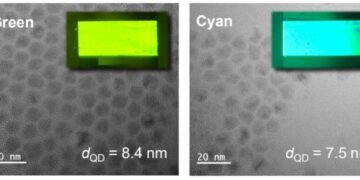Researchers have designed smart Intelligent lighting system based on quantum dots, color-controllable white-light devices from quantum dots—tiny semiconductors just a few billionths of a meter in size—that are more efficient and have better color saturation than standard LEDs and can dynamically reproduce sunlight conditions in light.
Researchers from the University of Cambridge have designed a next-generation intelligent lighting system using a combination of nanotechnology, colour science, advanced computing methods, electronics and a unique manufacturing process.
The team found that by using more than three primary colours of light in typical LEDs, they were able to more accurately reproduce sunlight. Early tests of the new design show excellent colour rendering, a wider operating range than current smart lighting technology and a wider range of white light settings. The results are published in the journal Nature Communications.
Since the availability and characteristics of ambient light are associated (smart Intelligent lighting system based on quantum dots) with well-being, the widespread availability of smart lighting systems can have a positive effect on human health, as these systems can respond to individual conditions. Smart lighting can also respond to circadian rhythms that regulate the daily sleep-wake cycle, so the light is reddish in the morning and evening and blue-white during the day.
If a room has enough natural or artificial light, good glare control and a view to the outside; it has a good level of visual comfort. In an indoor environment under artificial lighting, visual comfort depends on how accurately colours are displayed. Since the colour of objects is determined by light, smart white light must be able to accurately express the colour of surrounding objects. Current technology achieves this by using three different colours of light simultaneously.
Quantum dots have been studied and developed as light sources since the 1990s due to their high colour rendering and colour purity. Thanks to their unique optoelectronic properties, they show excellent colour performance in both wide colour control and high colour rendering capabilities.
Cambridge researchers have developed architecture for next-generation smart white light-emitting diodes (QD-LEDs). They combine system-level colour optimization, device-level optoelectronic simulation, and material-level extraction.
The researchers developed a computational design framework for a colour optimization algorithm used for neural networks in machine learning, along with new methods for modelling charge transfer and light emission.
The QD-LED system uses multiple primary colours – in addition to the commonly used red, green and blue – to more accurately mimic white light. By choosing quantum dots of a certain size—between three and 30 nanometers in diameter—the researchers were able to overcome some of the practical limitations of LEDs and achieve the emission wavelengths they needed to test their predictions.
The team then validated their design by creating a new QD-LED-based white light device architecture. The test showed excellent colour rendering, a wider control range than current technology and a wide range of white light settings.
The QD-LED system developed by Cambridge shows a correlated colour temperature (CCT) range from 2243 K (reddish) to 9207 K (bright afternoon sun), compared to current LED-based smart lights with CCTs between 2200 K and 6500 K. Submission Index colour index (CRI) – the measure of the colour emitted by the light compared to sunlight (CRI = 100) – of the QD-LED system is 97, compared to current smart bulb ranges that are not available between 80 and 91.
This design could pave the way for more efficient and accurate smart lighting. In an LED smart bulb, three LEDs must be controlled individually to achieve a certain colour. In a QD-LED system, all quantum dots are driven by a common control voltage to achieve a full colour temperature range.
“This is a world first: a fully optimized, high-performance quantum dot-based smart white lighting system,” said Professor Jong Min Kim of Cambridge’s Department of Engineering, who led the research. “This is the first milestone towards the full use of quantum dot-based smart white lighting for everyday applications.”
“The ability to better reproduce sunlight through its different collared colours that are dynamic in light is what we desire,” said Professor Gehan Amaratunga, who led the research. “We achieved this in a new way using quantum dots. This research paves the way for a wide range of new light-responsive human environments.”
The QD-LED white light structure developed by the Cambridge team is scalable for large-scale light surfaces because it is produced by a printing process and its control and drive are similar to those of a display. With standard point source LEDs requiring individual control; this is a more difficult task.





































